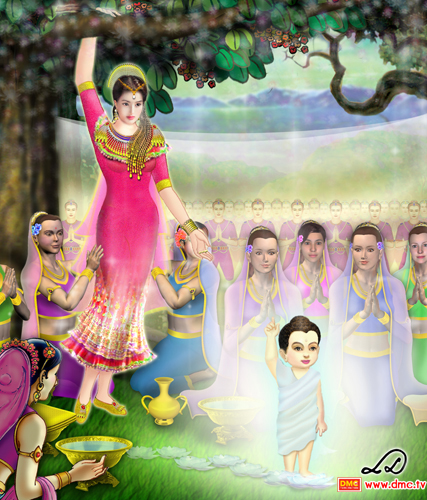
The birth of the Bodhisattva, the buddha-to-be, in Lumbini garden on the Indian frontier between 3,000 and 2,600 years ago, exact date unknown.
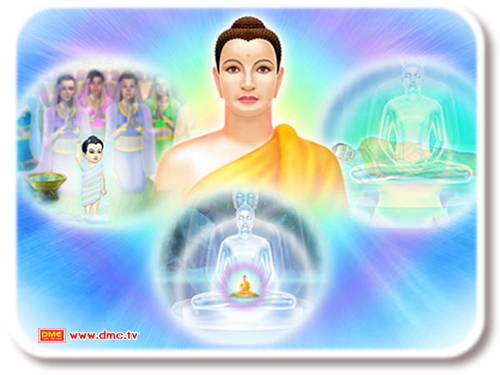
Vesak: the thrice blessed day because it was on the full moon day of the lunar month of Vesakha (ancient Indian calendar) that the Buddha was born to the Shakyan Queen Maya (apparently, according to Wisdom Quarterly research, a Salabhanjika) under a Sala tree in Lumbini garden, attained supreme enlightenment (which made him a buddha) under a Bo tree in Bodh Gaya ("Enlightenment Grove"), and passed into parinirvana, that is, nirvana without remainder laying down between twin Sala trees.
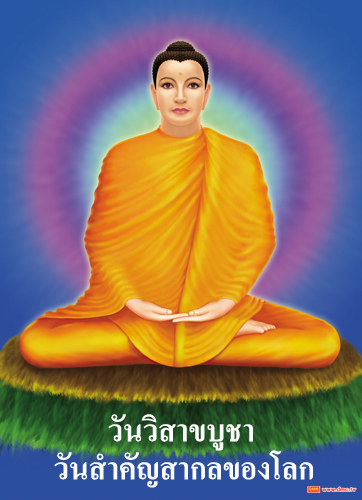
Siddhartha ("wish fulfilled") Gautama (his family name) became the Buddha of this age and was regarded as a famous karmavadin (teacher of the efficacy and importance of karma) and warrior caste (kshtriya) wandering ascetic opposed to the establish Brahminical tradition that relied on interpretations of sacred scriptures (the Vedas) and elaborate superstitious rituals carried out by a formal priestly caste (brahmins) over direct experience of the Truth. He was a knower and teacher of this world, other worlds, and the pathways leading to all kinds of rebirth. And with his tremendous following, the brahmins were not too happy about it. Much later, Adi Shankara decided to organize and standardize Buddhist-influenced Vedic Brahmanical schools, thereby creating what we recognize today as "Hinduism." Hinduism recognizes the Buddha but does a great disservice to his teaching by honoring him with the title of avatar, relegating him to a mere incarnation of the God Vishnu. The Buddha was not a God, not a deva, not spirit. He was a human who attained the incomparable status of a fully-enlightened teaching buddha. It is one thing, an accomplishment worthy of great praise and honor, to become enlightened. But it altogether an incomprehensible wonder to become a supreme teacher of the path to enlightenment.
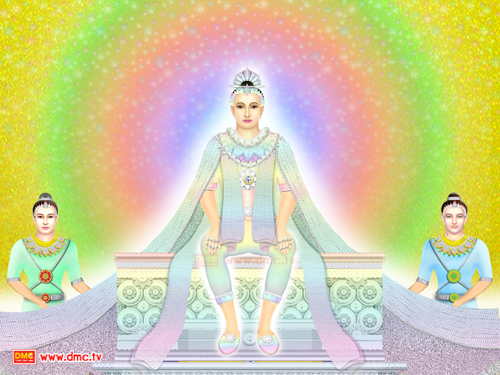
The devas ("shining ones," deities, divas, godlings, "angels," Earth-fairies, celestial-beings, bright spirits) rejoiced that the Bodhisattva as King Setaketu chose to consummate his quest for enlightenment by taking his final rebirth as a human being on Earth, Prince Siddhartha Gautama.
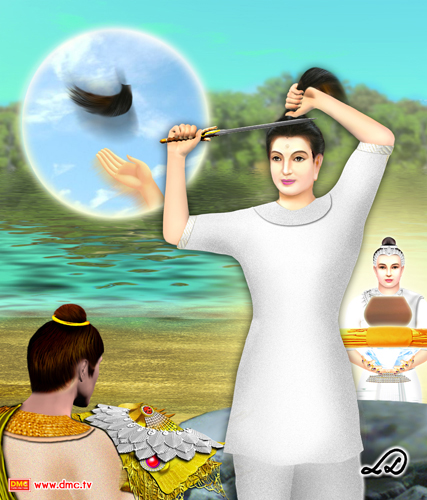
The Bodhisattva lived in luxury and splendor in Kapilavastu (either near modern Bamiyan, Afghanistan or in the Terai of Nepal, both of which are in view of the Himalayan foothills) but sensed that things were empty. Suffering (unsatisfactoriness) touched everyone and every endeavor. Touched by the inkling that he had a greater mission, he renounced the throne, the household life, family, and worldly fame. He discarded his fine clothes, cut off his gorgeous hair, and left his family's territory to go East in search of a guru and enlightenment (the final solution to suffering that all beings experience). His mission was not only to become enlightened but to rediscover the path in order to show the way to others; that is the difference between a supremely-enlightened buddha and an arhat ("enlightened individual").
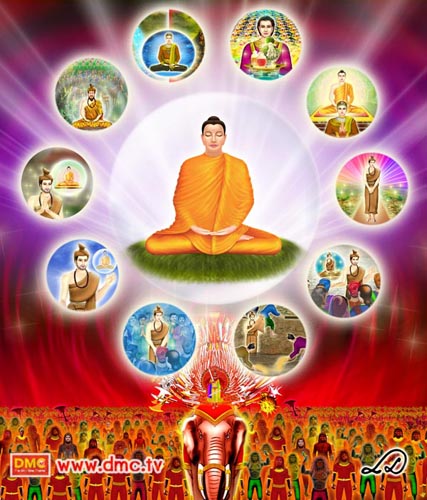
The Bodhisattva's struggle is steeped in lore. His life has been made an allegory to teach the Dharma by way of his example. While the essential facts may have survived, they have been mythologized and elaborated. His five-year struggle with two yogi-gurus to attain the exalted levels of serene meditation they taught are largely left out of the story. What is emphasized instead is his sixth year as he went off on his own, followed by five admirers eager to practice austerities with him. His fierce determination ruined his health and almost led to his death. Insight into the futility of fighting, struggling, and fiercely striving gave way to moderation. He understood that this wonderful body is a vehicle and of great help to reaching the goal. The first foundation of mindfulness, of which there are four, is the body. His mythical battle with internal "demons" is represented as a great offensive by Mara and an army of yakkhas ("demons") representing the psychological defilements we all possess that obstruct clear seeing and liberation.
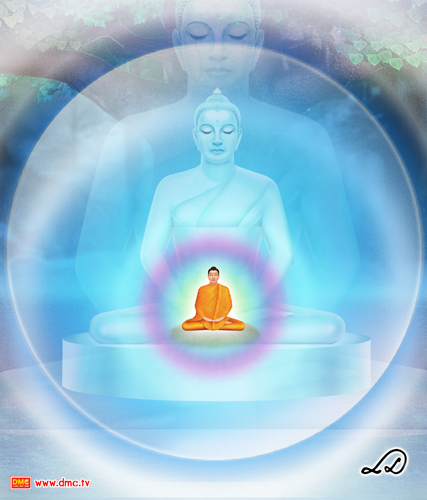
Taking a balanced approach -- eating well, resting, keeping a regular schedule -- he persisted. He realized that the sublime pleasure born of serenity meditation was not a hindrance but an aid to insight. The defiled mind/heart (contaminated by the hindrances and fetters) cannot free itself. But the heart/mind temporarily freed of these obstructions, if it practices insight-meditation (examining dependently originated nature of unhappiness), can realized the Truth. And it is the Truth that sets one free. While he may have determined to not get up until he found freedom under the Bodhi tree, that resolution was only made after having come so far in his meditation that his mind was now luminous and ready to break through.
- EDITORIAL NOTE: If we practice with that determination, we are sure to fail -- because most of us have not done the preliminary work of cultivating the eight stages of serenity meditation that make the mind malleable, intensified, wieldy, and luminous. But this so often gets left out of the myth of the Buddha's glorious, take-no-prisoners, gung ho charging into battle against temptation. That is no way to win a war, and it is utterly impossible to win the peace this way.
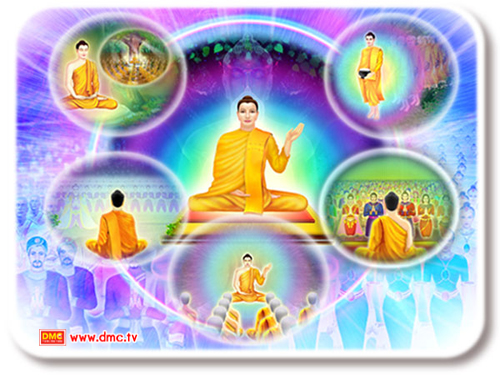
Having attained the goal, the "Sage of the Shakya clan" (Shakya-muni) revered the Bodhi tree, rejoiced in the liberation of mind and liberation of heart through wisdom and virtue. Having found his way out of compassion for others, he was drawn to teach. But he well understood that it would be difficult to show anyone so subtle a Dharma, so non-polemic an answer, to teach the Middle Way. He decided to remain silent. Sakka, King of the Devas, came to ask him to reconsider out of compassion and particularly to help those who had "only a little dust in their eyes" who, with his help, would surely be able to realize the Truth. A brahma named Sahampati immediately came and repeated this entreaty, and the Buddha consented. He set out to teach his five former companions, seeing that his yogi-teachers had by then passed away. As others followed the practice and became enlightened by the practice, the Dharma grew. The Buddha continued to teach throughout the civilized and very spiritually advanced realm called the Rose "Apple Land" in the Middle Country (Jambudvipa, northern India), living mostly in Magadha.
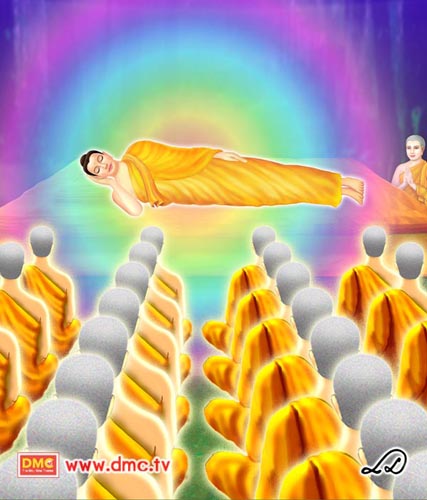
His goal was not only to teach but to establish the teaching, or Dharma, through the ordination of monks, nuns, and male and female lay followers. The Buddha earned the title "the teacher of gods and men," which refers to the fact that he taught both devas and human beings. Devas live on Earth and in many extraterrestrial worlds. He and his disciples visited them, and they visited. In fact, more devas reached enlightenment than humans. (And it seems that in straight numbers, not proportions, more lay followers reached at least the first stage of enlightenment than monastics). The Sangha or "monastic community" grew and overtook the Vedic Brahmanism, the established religious authority. Although it is popularly believed that he did not want to ordain women, in fact, he stated that his Dispensation (sasana) would not be complete until all four types of disciples (male and female monastics and male and female lay followers) existed. Only in this way was the Dharma to have longevity. With the loss of nuns, who seem to have been sabotaged by the sexism prevalent in the world and by conspiracies by monks to undermine and subordinate them, the lifespan of the Dharma was threatened. But finally that segment of the Sangha is again on the rise.
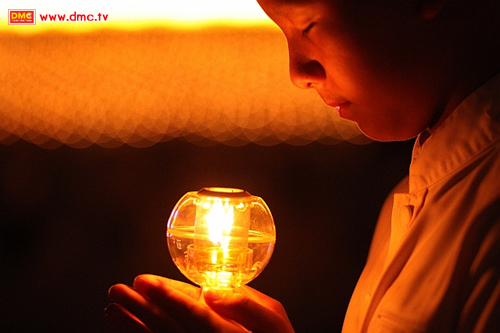
Dhammakaya, Thailand's reawakening annual worldwide candlelight celebration in honor of Vesak. 2011 marks the 2,600th Vesak in Buddhist history. This means that it has been twenty-six centuries since the Buddha sat smiling under the Bodhi tree, having rediscovered the liberating Truth. This celebration takes place every year throughout the world where the Thai Theravada tradition has become established. The Los Angeles branch, perhaps the largest in America, celebrates tonight at 5:00 pm in the foothill city of Azusa.




















































































































































































































































No comments:
Post a Comment